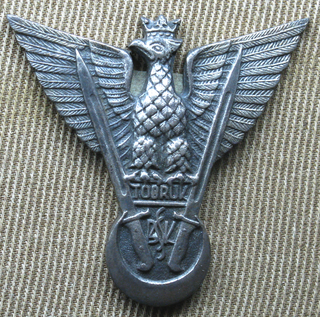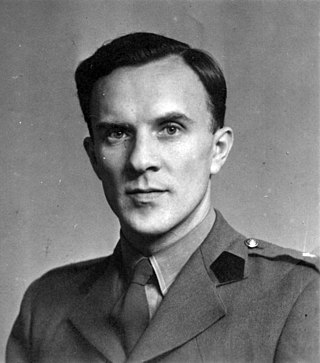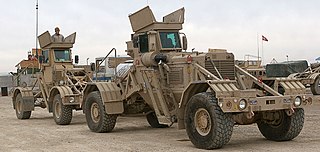
A land mine, or landmine, is an explosive weapon concealed under or camouflaged on the ground, and designed to destroy or disable enemy targets, ranging from combatants to vehicles and tanks, as they pass over or near it.

The Second Battle of El Alamein was a battle of the Second World War that took place near the Egyptian railway halt of El Alamein. The First Battle of El Alamein and the Battle of Alam el Halfa had prevented the Axis from advancing further into Egypt.

In World War II, the Polish armed forces were the fourth largest Allied forces in Europe, after those of the Soviet Union, United States, and Britain.[a] Poles made substantial contributions to the Allied effort throughout the war, fighting on land, sea, and in the air.

A metal detector is an instrument that detects the nearby presence of metal. Metal detectors are useful for finding metal objects on the surface, underground, and under water. A metal detector consists of a control box, an adjustable shaft, and a variable-shaped pickup coil. When the coil nears metal, the control box signals its presence with a tone, light, or needle movement. Signal intensity typically increases with proximity. A common type are stationary "walk through" metal detectors used at access points in prisons, courthouses, airports and psychiatric hospitals to detect concealed metal weapons on a person's body.

The Vickers 6-ton tank or Vickers Mark E, also known as the "Six-tonner", was a British light tank designed in 1928 in a private project at Vickers. Though not adopted by the British Army, it was picked up by several other armed forces, and licensed by the Soviet Union as the T-26. It was also the direct predecessor of the Polish 7TP tank.

Crusader, in full "Tank, Cruiser Mk VI, Crusader", also known by its General Staff number A.15, was one of the primary British cruiser tanks during the early part of the Second World War. Over 5,000 tanks were manufactured and they made important contributions to the British victories during the North African campaign. The Crusader only saw active service in Africa but the chassis of the tank was modified to create anti-aircraft, fire support, observation, communication, bulldozer and recovery vehicle variants.

In anti-tank warfare, an anti-tank mine is a type of land mine designed to damage or destroy vehicles including tanks and armored fighting vehicles.

The Battle of Alam el Halfa took place between 30 August and 5 September 1942 south of El Alamein during the Western Desert Campaign of the Second World War. Panzerarmee Afrika, attempted an envelopment of the British Eighth Army. In Unternehmen Brandung, the last big Axis offensive of the Western Desert Campaign, Rommel intended to defeat the Eighth Army before Allied reinforcements arrived.

Polish Independent Carpathian Brigade was a Polish military unit formed in 1940 in French Syria composed of Polish soldiers exiled after the invasion of Poland in 1939 as part of the Polish Army in France. It was commanded by General Stanisław Kopański.

The Ordnance Quick-Firing 6-pounder 7 cwt, or just 6-pounder, was a British 57 mm gun, serving during the Second World War as a primary anti-tank gun of both the British and United States Army. It was also used as the main armament for a number of armoured fighting vehicles.

Demining or mine clearance is the process of removing land mines from an area. In military operations, the object is to rapidly clear a path through a minefield, and this is often done with devices such as mine plows and blast waves. By contrast, the goal of humanitarian demining is to remove all of the landmines to a given depth and make the land safe for human use. Specially trained dogs are also used to narrow down the search and verify that an area is cleared. Mechanical devices such as flails and excavators are sometimes used to clear mines.

The Light Tank Mark I to Mark V were a series of related designs of light tank produced by Vickers for the British Army during the interwar period.

A mine flail is a vehicle-mounted device that makes a safe path through a minefield by deliberately detonating land mines in front of the vehicle that carries it. They were first used by the British during World War II.

Józef Kosacki was a Polish professor, engineer, inventor, and an officer in the Polish Army during World War II. He is best known as the inventor of the Polish mine detector, the first portable mine detector, whose basic design has been in use with various armies for over 50 years.
The L9 bar mine is a large rectangular British anti-tank landmine. The bar mine's principal advantage is its long length, and therefore its trigger length. A typical anti-tank landmine is circular, and a vehicle's wheels or tracks, which make up only a small proportion of its total width, must actually press on the mine to activate it. To increase the probability of a vehicle striking the mine, the mine's effective trigger width must be increased.

The Devil's gardens was the name given by Field Marshal Erwin Rommel, commander of the German Afrika Korps during the Second World War, to the defensive entanglements of land mines and barbed wire built to protect Axis defensive positions at El Alamein before the Second Battle of El Alamein in late 1942. The defences stretch from the Mediterranean coast to the Qattara Depression. An estimated 16 million mines, planted by the Europeans during the world wars and called "devil's gardens", still hinder development of most of Matrouh Governorate, and are constantly being removed.

The Husky VMMD is a configurable counter-IED MRAP vehicle, developed by South African-based DCD Protected Mobility and American C-IED company Critical Solutions International. Designed for use in route clearance and de-mining operations, the Husky is equipped with technologies to help detect explosives and minimise blast damage.

The Battle of El Agheila was a brief engagement of the Western Desert Campaign of the Second World War. It took place in December 1942 between Allied forces of the Eighth Army and the Axis forces of the German-Italian Panzer Army, during the long Axis withdrawal from El Alamein to Tunis. The Eighth Army planned to outflank and trap the Axis forces as they withdrew to Tunis.
185th Paratroopers Division "Folgore" was an airborne division of the Royal Italian Army during World War II. The division was formed in Tarquinia near Rome on 1 September 1941. In July 1942 the division was sent to Libya to fight in the Western Desert Campaign and was destroyed during the Second Battle of El Alamein in early November 1942.

El Alamein - The Line of Fire is a 2002 Italian war-drama film written and directed by Enzo Monteleone. The film won three David di Donatello awards, a Nastro d'Argento for best sound and a Globo d'oro for best new actor. The film is set during the Second battle of El Alamein, which is seen from the Italian perspective.



















